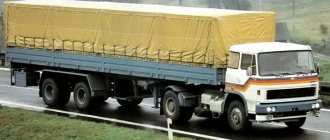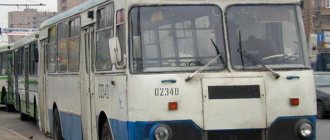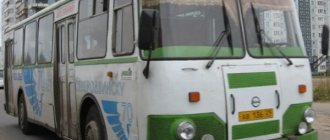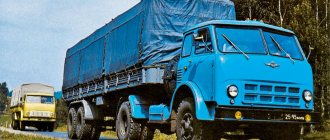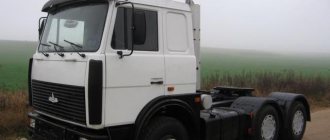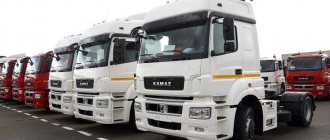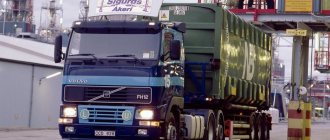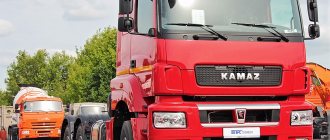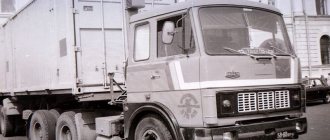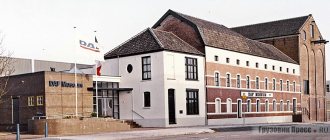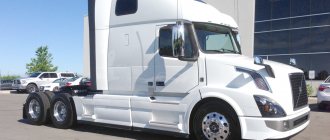- Story
- Characteristics
- Reviews
- The lineup
- Video reviews
Skoda Liaz
The date of birth of the automobile company Skoda LIAZ is considered to be 1951, since before that time both enterprises - LIAZ and Skoda - existed separately. At different periods of time, the company included up to 12 enterprises of various profiles located in different cities, and in the 70s of the last century, Skoda LIAZ was the largest manufacturer of trucks in Czechoslovakia.
The following video tells about the rich history of LIAZ-Skoda:
Models 706 D and 706 R: features and technical specifications
The basis for the first truck that the company began to produce was the Skoda 706 D. Having a load capacity of 7 tons and a power of 110 hp. s., during the war, trucks were produced for the needs of the Wehrmacht. Before production resumed in 1946, modernization was carried out. The car was equipped with a new cabin and the power was increased by 25 hp. With. The updated version received the index 706 R and was presented in 1949 in Moscow at the Czechoslovak Automobile Exhibition. Vans, buses, dump trucks and special-purpose vehicles were subsequently produced at its base. The use of a common database greatly simplified the ordering of spare parts, regardless of the intended use of the vehicle.
The development and production of Liaz trucks had been established even before the war.
The truck was equipped with a 6-cylinder diesel engine, the design features of which made it possible to remove the pistons and connecting rods from the block without dismantling the entire engine. There were glow plugs in each cylinder. The fuel pump was equipped with a centrifugal distributor that supplied fuel to the injectors. The water cooling system was equipped with a thermostat.
The maximum declared speed of the car was about 53 km/h, but in reality it rarely exceeded 40 km/h with an average fuel consumption of approximately 30 liters per 100 km. The diesel engine was paired with a 5-speed manual transmission.
The vehicle was equipped with an engine brake, something most diesel trucks of the time did not have.
The 706 R's cabin was spacious, with room for the driver and three passengers, and was made of wood covered with steel sheets.
Technical characteristics of the Skoda liaz 100.42 truck
The two-axle new product weighed 19 tons, but as part of a road train its weight reached 38 tons. Thanks to this, the technical potential of the vehicle became much wider and made it possible to solve a lot of problems, especially in the field of long-distance cargo transportation.
Engines with increased power of 201 hp also appeared here, thanks to which the car could easily reach speeds of up to 98 km/h. For 100 liters the car required 37 liters of fuel, which even in current conditions is considered a moderate figure. The gearbox did not shine with uniqueness, and was a simple but reliable 5-speed mechanism.
A few months later, the modification was supplemented by tractors, which received the index 100.45, and after some time - flatbed trucks 100.05.
New model – 706 RT and its modifications
In 1957, the 706 R was replaced by a new model - the cabover RT. It was she who soon became a truly massive phenomenon on the roads of the Soviet Union. Based on this model with 160 hp engine. With. and direct fuel injection, dump trucks RTS1 (with unloading on one side), RTS3 (with unloading on three sides), RTO bus chassis, Skoda RTTN truck tractor and other modifications were produced.
In the 60s, mass deliveries of the Skoda 706 RT family to the USSR began. The main type of semi-trailers with which Czech tractors worked in the Soviet Union were refrigerators, the purchase of which began in 1964. Vehicles for various purposes based on RT have earned popularity due to their reliability and endurance in operation. The gearbox, engine and main components worked perfectly, and if necessary, it was easy to find spare parts for repairs.
The comfort of the driver's seat was incomparable to what domestic manufacturers offered our drivers.
Series 706 MT
In 1966, production of the Skoda 706 MT series with a 180 hp engine was launched. s., and since 1969 – the MT4 and MT5 series with a 210-horsepower engine and a 5-speed gearbox. The MT family also received an updated cabin, and in 1973 production of double cabins for vehicles operating over short distances began.
The end of production of the series was the development and release of the new model Liaz 100, production of which began in 1974 with truck tractors, and subsequently flatbed trucks. Nevertheless, Skoda 706 series dump trucks were produced until 1987.
Skoda Liaz 110
The popular Skoda Liaz 110 model, again, received a number of visual changes. There is practically nothing left of the former exterior here. Another individual characteristic is the M630 engine (210 and 320 hp), the presence of an anti-lock braking system and a Maxi-class cab (in configuration 110.573).
For the first time, the cabin was able to tilt back. The rear air suspension was also a key factor in determining the popularity of the 110th model.
Like its predecessor, it was actively exported to the USSR. The 100-110 tandem was a real guarantor of quality and reliability, which could often be found on long roads.
LIAZ family
Presented at the exhibition in Brno in 1973, the LIAZ 100 family at that time consisted of only two vehicles - a flatbed truck and a truck tractor with indexes 100.45 and 100.05, respectively. Mass production of new models began in 1974, and an update to the family was introduced in 1984. It included the Skoda Liaz 110 series with a tilt-forward cab, as well as three-axle 122 vehicles, represented by a 26-ton flatbed truck 122.03 and a tractor 122.48 for 42-ton road trains.
The new generation of Czechoslovak Skoda Liaz 110 trucks was distinguished by an unusually stylish and thoughtful design. This was preceded by the creation of several prototypes, which ultimately made it possible to create a truly optimal model with perfectly crafted details and standardized spare parts. New MS638 and MS637 engines designed for LiAZ, equipped with 6 turbocharged cylinders, produced power of 270 and 304 hp at 2000 rpm. With. The mounting of both engines was designed in such a way that each of them could be installed on any modification. Tilting the cylinders 45 degrees created more space for the middle seat and lowered the cabin floor. Also behind the seats in the cabin there was a luggage rack and a berth, which the previous model could not boast of.
Interestingly, around the same time, Renault granted the AVIA factories a license to produce light-duty trucks, and LIAZ immediately attempted to install a French cab on its tractors. However, this idea turned out to be unsuccessful, and the Czechs returned to their own design.
Soon modifications of Skoda with a short cab, three- and four-axle models, and an all-wheel drive chassis with a passenger body (Africabus model) were developed. Opportunities for cooperation were not missed. For example, a cab with a special radiator lining and a high seating position was developed for Tatra trucks.
Skoda tractor unit. Liaz - the history of the Skoda truck line
09 Oct 2013 | Articles and reviews | Evgeny Zenkov | Discuss
After the war, the leadership of Czechoslovakia decided to reduce the range of cars and trucks produced at various factories in the country. As a result, the Škoda automobile plant began building railway locomotives, and the production of trucks and buses was transferred to the Avia company in Letnany. By agreement with the design developer, the Škoda company, the same emblem remained on the linings of their radiators and the company name was retained.
The first post-war Škoda truck was named
Škoda 706 R , its production was established in Letnany from 1946 to 1951, and in June 1951 production was transferred to a plant in the village.
Rynovice, now part of the city of Liberec. In 1952, the new plant, together with branches in the cities of Mnikhovo Gradishte and Ganychov, became. Subsequently, this group of enterprises became the basis). Development of the Škoda 706 R began back in 1930, then the model was called Škoda 706. The post-war model differed from the 1930 model in a more spacious cabin, a more powerful diesel engine and had a greater load capacity - 7300 kg.
The diesel engine installed on the Škoda 706 R was a 6-cylinder with wet liners and pre-chamber mixture formation, and had several design features that greatly facilitated its repair and maintenance. The crankshaft was assembled at the factory from seven parts, and it rotated in a powerful crankcase on seven large-diameter roller bearings. During repair work, the pistons together with connecting rods could be removed from the block without dismantling the diesel engine from the car. The light alloy pistons contained four compression rings and one oil scraper ring.
The timing camshaft with pushers and rocker arms was driven from the crankshaft by a gear drive. The diesel engine was equipped with a compressor that served the car's pneumatic braking system, and was driven by a gear transmission from the crankshaft. Two filters with replaceable paper elements were installed in the oil line. Starting a cold diesel engine was facilitated by glow plugs located in each cylinder. A fuel injection pump with a centrifugal-type distributor supplied fuel through steel tubes to injectors that were easily dismantled for maintenance. The cooling system included a thermostat that controlled the flow of water in the water jacket.
The diesel engine capacity was 11,781 cm3 and had a power of 135 hp. at 1750 rpm. The maximum speed was 53.5 km/h. In real operating conditions, the truck's speed rarely exceeded 40 km/h. Average fuel consumption was about 30 liters per 100 km. Oil consumption was also quite high - 1 liter per 100 km!
Paired with a diesel engine, the Škoda 706 R was equipped with a 5-speed manual transmission with three pairs of constant mesh gears. The steering included a worm-roller type actuator, with low force on the steering wheel achieved by a large gear ratio and a huge diameter of the steering wheel. The designers installed an engine brake (a flap in the exhaust manifold), which many other European diesel trucks of that time could not boast of having.
The cabin of the Škoda 706R trucks was very wide - a driver and 3 passengers could easily fit in it. The cabin frame was made of wood and lined with steel sheets. In 1954, the cabin was replaced with an all-metal one, but by 1956 they had already decided to abandon it, because in 1956, a model with a “cabin over engine” layout was presented. Trucks with such a cab, welded from steel elements, were assigned the index 706RT . Flatbed trucks were equipped with a wooden platform measuring 5000x2350 mm with three folding sides and a steel frame at the base of the floor.
In 1954, the trucks of the 706R family were modernized: a new radiator lining and fenders became more technologically advanced, and access to the engine for repair and maintenance was made easier (small areas appeared to the right and left of the hood, located behind the front bumper). Maximum diesel power increased to 145 hp. With. at 1800 rpm, which increased the maximum speed to 68 km/h. The modernized models with an onboard platform were distinguished by increased load capacity up to 7750 kg and consumed 32 liters of fuel per 100 km. Production of the 706R continued for another three years before it was discontinued in 1957.
The 706R was replaced by
the Škoda-706MT .
The model received an updated cabin, which differed from the previous one only in the design of the front part. The new cabin was installed on cars of the MT family and on those that continued to be produced RT. In 1973, a double cab was developed for vehicles operating on short routes - before that, all Škoda-706RT/MT were equipped with a “long” cab with a berth. Simultaneously with the production of flatbed versions, the assembly of 706RS with metal platforms that unloaded on three sides began. The load capacity of the dump truck was limited to 6.5 tons with a curb weight of 7.26 tons. Their main area of application was urban and suburban construction. Another version of the truck was the Škoda-706ROK with a front cabin unified with a bus. Cars, as a rule, were offered as carriers of specialized equipment (as garbage trucks, etc.) or in the form of a van.
Škoda- 706RS
dump trucks played a significant role in the restoration of destroyed factories and cities in Czechoslovakia in the first post-war decade. Wheels with large tires (12.00-22) and huge ground clearance (250 mm) in the presence of a high-torque diesel engine provided the loaded vehicle with good cross-country ability, including on dirt roads. The presence of a heater, a relatively small force on the steering wheel and on the gearshift lever formed drivers' opinion of the Škoda-706RS (and in general of the entire line of 706R models) as a car that is convenient to operate at any time of the year. The design of the engine and transmission, proven over a decade, and the high quality of manufacturing of the cars guaranteed their excellent reliability and durability.
The rise and fall of the popularity of Skoda Liaz trucks
The Skoda Liaz is a legendary truck produced in the former country of Czechoslovakia. The history of the enterprise dates back to the middle of the last century, when the country's leadership decided to move production from the AVIA plant to Lyubertsy. It is curious that in the 70s the enterprise was the largest in the country for the production of trucks. The machines were highly reliable, easy to maintain, and had other advantages, which we will discuss later.
Skoda LIAZ: trucks from Czechoslovakia
The date of birth of the automobile company Skoda LIAZ is considered to be 1951, since before that time both enterprises - LIAZ and Skoda - existed separately. At different periods of time, the company included up to 12 enterprises of various profiles located in different cities, and in the 70s of the last century, Skoda LIAZ was the largest manufacturer of trucks in Czechoslovakia.
The following video tells about the rich history of LIAZ-Skoda:
How it all began?
The emergence of the enterprise was preceded by a grandiose reconstruction of small factories in several localities in Czechoslovakia. As a result of the merger of small factories, a large manufacturing plant was formed, called the Lyubertsy Automobile Plants. It is noteworthy that the resulting enterprise was part of AZNP, the main Skoda plant. A year after the merger, LIAZ gained autonomy, but at the same time, the trucks coming off the assembly line were called the double name Skoda Liaz. This continued until 1984.
LIAZ family
In 1973, an exhibition of trucks was held in the city of Brno, at which the family of the company in question was represented by only two models - a truck tractor and an onboard tractor. Serial production of the models began in 1974. Updates affected truck transport in 1984, when vehicles with tilting cabs and three-axle vehicles were introduced.
The new generation Skoda trucks compare favorably with many foreign analogues and their predecessors, having an excellent design and style. But this did not happen right away: at first, the management and engineering staff of the plant had to work hard to create an excellent truck. So, before getting what we wanted, we had to work on several prototypes. After some time, the company began to produce Skoda Liaz with shortened cabs, three- and four-axle modifications from the assembly line.
Model 706
Since 1957, modifications have been made at the factories of the united enterprise:
- 706RTS dump trucks;
- truck tractors 706RTTN;
- chassis 706RT.
The last option implied the creation of flatbed trucks, buses and all kinds of cars with narrow specializations. All modifications were equipped with engines designed for 160 hp. Other characteristics include:
- Diesel engine
- Fuel injection
- Engine powers are 160, 180 and 210 hp. With.
Model 100
Appearing in 1974, the two-axle truck weighed 19 tons. The novelty meant operation as part of road trains weighing up to 38 tons. This quality significantly expanded the boundaries of professional tasks for carriers.
Model 110
The changes in design and style were dramatic, as the new appearance of the truck was completely different from the exterior of its predecessors. Initially, the truck was equipped with one of five M630 engines. Later, an anti-lock braking system and a Maxi cab appeared. Other characteristics:
- The direction of the bulk of exports is the USSR
- Motor model - M630
- Engine power - 210-320 hp. With.
As far as I understand, starting in the mid-1960s, three main versions of this model were supplied to the USSR, although not a single reference book available to me says this. But on atchercules.ru/cs three modifications of the engine installed on these trucks are indicated (engine brands and years from other sources): S706RT 160 hp. With. 1960, M630 180 l. With. 1966 and M634 210 l. With. 1969 Which, in general, coincides in years with changes in the front end and radiator trim. But it’s not a fact, and truck driver DraiverJM doesn’t write about it on rcforum.ru, but you can’t argue with the photograph. As the great satirist A.I. Raikin said: “It’s clear that it’s a dark matter.” It is a pity that in Soviet times the dissemination of information about imported cars, especially those that were superior to ours in performance indicators, was not welcomed.
Manufacturer: LIAZ Liberecke Automobilove Zavody, LIAZ - Liberec Automobile Plants, Mnikhovo Hradište, Jablonec na Nisa, Liberec, Czechoslovak Socialist Republic.
RTTN - rekonstruovaný, trambusový návěsový tahač.
Source: dostavka99.ru
The letters and their combinations after the main index of the 706 model indicate the purpose of the cars.
R is a reconstructed car, that is, redesigned.
RT is a reconstructed trambus (in Czech, a trambus is a truck with a cab above the engine).
MT - Modernized trambus.
RTTN is a reconstructed trambus truck tractor.
MTS is a modernized dump truck.
Truck tractors Škoda-706RTTN with refrigerated semi-trailers from the Orličan car assembly plant in Chocen (first N9CH, and then Alka N12CH and N13CH) replaced the Austrian OAF with Tranberg semi-trailers and the Hungarian Csepel D450N with Csepel and Ikarus semi-trailers in the mid-1960s . They were intended for the transport of frozen or chilled food, medicines and cosmetics, as well as goods that need to be protected from frost. Transportation was carried out on the floor or on hanging movable hooks (hook load capacity 250 kg).
At the turn of the sixties and seventies, these road trains were also used by Sovtransavto for international transport. However, their share in the vehicle fleet of this enterprise was not so significant. From 1968 to 1973, the main, basic truck tractor operating at Sovtransavto was the MAZ-504. In 1973, a new Swedish car, the Volvo F89, joined its ranks, and after some time, Mercedes-Benz L2232S truck tractors began to arrive.
https://atchercules.ru/cs/istoriya-marki-skoda-istoriya-marki-skoda-modelnyi-ryad-liaz.html (translation): “Model 706. This unit began to be supplied to the Soviet market in the 60s. The main configuration is a refrigerated road train. Unlike local models, the 706 is easier to operate and is also adapted to harsh conditions.
Modifications 706:
706RTS, tipper type;
706RTTN, tractor unit;
Chassis 706RT, which was used for the production of buses, special vehicles and flatbed trucks.
Each model was produced with a 160-horsepower engine. A little later, cars began to be equipped with diesel engines with a fuel injection system. In terms of power, the power unit was divided into several types: 160, 180 and 210 hp. With.
The Škoda Liaz completed its journey in 1985. It was replaced by Liaz 100. The story ended in the late 90s. The collapse of the USSR and the inability to compete with more advanced analogues led the company to serious financial problems. The plant, having gone bankrupt, curtailed production, but forever left its mark on the history of European and domestic mechanical engineering.”
Interesting information from truck driver Yuri Sergeevich, DraiverJM on rcforum.ru
“Skoda 706RTTN with Alki No. 12 was delivered until 1981, without noticeable factory upgrades. Since 1981, LIAZ 100.42 truck tractors and Orličan N13CH refrigerated semi-trailers began to arrive.”
And further:
“In the early seventies, a new family was developed. These cars received the new LIAZ brand, without mention of Škoda (although the LIAZ plant became independent back in 1953, it produced trucks with the Škoda logo for another 20 years). The first to go into production in 1974 were LIAZ 100.05 trucks and LIAZ 100.45 truck tractors. The start of production of LIAZ 100 did not lead to immediate purchases. The conservatism of Soviet operators probably played a role, as they preferred an outdated, but reliable and well-developed model. The first LIAZ cars were delivered to the USSR only in the early eighties. These were road trains consisting of LIAZ 100.42 truck tractors and Orličan N13CH refrigerated semi-trailers. After lengthy tests, a purchase decision was finally made, and in 1982, LIAZ tractors began to arrive in the USSR. The bulk of the deliveries were LIAZ 100 truck tractors, modifications 42, 45 and 47, working with N13CH, later N14CH, and 55 Turbo refrigerated semi-trailers for international transport.
With the start of production of LIAZ 110, deliveries continued. As with the LIAZ 100, tractor units were supplied to work with Orličan refrigerated semi-trailers. LIAZ 110.551 truck tractors for long-distance and international transport were supplied in smaller quantities.
With the collapse of the socialist camp and the division of Czechoslovakia, LIAZ entered a period of crisis. Compared to Western European trucks, LIAZ lost in almost all respects. Soviet purchases ceased, and they accounted for the bulk of deliveries of LIAZ vehicles. The cars already delivered to the USSR did not remain in service for long - the lack of spare parts led to their rapid departure from the scene.”
Loss of popularity and decline of the company
The main strategic partner of Czechoslovakia during the years of production of the LiAZ family of cars was the USSR, but this did not mean instant popularity for the company with the release of the LIAZ 100. Sales activity was observed in the early 1980s, when the main imported product was a truck tractor. The association between School and Liaz began to rapidly decline. Insufficient popularity of the machines, insignificant requests from importers, and an undeveloped sales market are the reasons why the company began to approach bankruptcy.
In 1989, LIAZ became independent, and with the advent of 1992, it took the form of a joint stock company. After several years, Skoda acquires the remaining shares from Liaz. At that time, four generations of trucks rolled off the plant’s assembly lines.
It took the reorganized enterprise just a few months from 1992 to release a new member of the family, named 400 XENA. The model was distinguished by an American diesel engine with a power of 530 hp. With. In addition, the innovative design and improved construction of the tractor were good news.
Be that as it may, the truck did not receive due recognition - over a period of several years, no more than a hundred vehicles rolled off the assembly line. The loss of the sales market along with the collapse of the Soviet Union did not benefit the manufacturer; as a result, it did not receive income for further competition with Western and European analogues. At the end of the 90s, a difficult part of the company’s history began.
History of the Liaz brand
The history of LIAZ begins in the early 50s, when Skoda trucks, which were produced at the AVIA Prague plant, were transferred to the city of Liberec in northern Czechoslovakia. For this purpose, some small mechanical enterprises located in the small towns of Rynovice, Liberec, Mnikhovo, Hradiště, and Svijany Loukov were reconstructed.
They first became part of the parent People's Enterprise (AZNP) in Mladá Boleslav and formed the Liberecke Automobilove Zavody, abbreviated LIA3 (LIAZ). On January 2, 1952, production of the Skoda-706R cabover trucks began in Rynovitsa, and by January 1, 1953, when the LIAZ enterprise gained independence, over 950 vehicles were manufactured. The composition and profile of the factories that were part of LIAZ (up to 12 enterprises) changed repeatedly.
Over time, the main plant became the one in the town of Jablonec na Nisa, which absorbed Rynovice. The assembly of the new Skoda-706KT and 706MT trucks began in the city of Mnichovo Hradište, and the engines for them were first produced in Hynikhovo, and then in Jablonec na Nisa. These simple, durable and unpretentious vehicles became the basis of the new “100” series of heavy cab-over trucks, which sought to conquer the markets of industrialized countries. Developed at LIAZ enterprises, the cars received a new trademark “LIAZ”, which replaced the well-known name “Skoda” for 20 years.
The first series of “LIAZ 100” consisted of 2-axle trucks with a total weight of 16-19 tons and truck tractors for road trains with a total weight of 36-38 tons. In 1974, production of the “LIAZ 100.45” truck tractor began, and a year later - 8 ,5-ton trucks “100.05”. From the “706MT” range, only dump trucks “MTS24” (4×2), “MTSP24” and “MTSP27” (4×4) remained on the conveyor. The second generation of LIAZ cars began to take shape in the early 80s. In 1984, with the creation of a tilting version of the first cab, the “110” series appeared, which received rear air suspension, as well as the “122” (6×2) family of 3-axle vehicles, which consisted of a “122.03” flatbed truck with a total weight of 26 tons. and the “122.48” truck tractor for 42-ton road trains.
85 built several “100.55D” (4x4) trucks for the Paris-Dakar marathon, which gave birth to the all-wheel drive “111” series. In the 1987 rally, the LIAZ 111.154 version achieved the highest result for the plant, taking third place. Since 1987, production of dump trucks “150” (4×2) and “151” (4×4) began, which finally replaced the “706MT” series, as well as the second basic family “200”, which differed only in enhanced cabin sound insulation and brakes with ABS. All cars could be ordered with one of five options for the in-line 6-cylinder diesel engine “M630” (11946 cm 3) with direct injection, several types of gearboxes and four wheelbase sizes.
In the 80s the engine had versions “M634”, “M636”, “M637”, “M638” and “M640” with power from 210 to 320 hp, including options with turbocharging and intercooling. Despite this, the LIAZ plant was never able to create cars that fully meet the stringent requirements of Western European countries. By the end of the 80s. The demand for LIAZ cars began to decline rapidly. On economic and technical problems in the early 90s. added to the collapse of Czechoslovakia. In the new economic conditions, the enterprise not only lost its main foreign markets, but was also unable to withstand competition in the domestic market.
At this time, the LIAZ plant made efforts to modernize its program. So in 1990-92. truck tractors “110.573” with an increased volume cab “Maxi” (Maxg) and ABS appeared, as well as the model “230.575”, for the first time equipped with an in-line 6-cylinder 4-stroke engine “Detroit Diesel” of the “60” series (12742 cm 3, 365-400 hp). By the mid-90s. An updated program consisting of five basic families was formed. The first series “S” and “FZ” included delivery trucks with a total weight of 9-17 tons with a 6-cylinder Steyr diesel engine with a capacity of 180 “horses”.
The cars differed in whether they had cabins of their own production or those assembled under an Austrian license. The “300” series consisted of the more than once modernized “100” family with wheel arrangements from 4x2 to 8x4 with a total weight of 18-40 tons. Their options were the “M300” truck tractors with basic turbocharged engines (models “M636E/S”, “M640F/S/T” and “M640FE/SE/TE”, 230-408 hp), as well as “ Detroit Diesel” (355-450 hp). The fifth family consisted of trucks of the “110”, “150” and “250” series with the previous “M636”, “M637” and “M640” engines (208-305 hp) in the so-called “Euro-0” version for countries where strict environmental regulations are not yet in place.
In 1992, the three-year privatization of LIAZ enterprises began. In 1995, the heavy engineering concern Skoda became the main owner of the shares, and the new joint-stock company became known as Skoda-LIAZ. Since then, all products have received a new trademark “Skoda-LIAZ” and other indexing.
©. Photos taken from publicly available sources.
Price
If you wish, you can buy a car for 200,000 - 300,000 rubles.
In 1951, the national automobile manufacturing enterprise LIAZ was founded in the north of the Czech Republic. This abbreviation stands for “Liberec Automobile Plants” - production facilities were located in various localities in the Liberec region. The production of heavy trucks and buses of the Skoda 706 family was established here.
Since 1974, the company began to simultaneously produce cars of a new series - LIAZ 100. The cars were intended primarily for long-distance and international road transport. Ten years later they received a tilting cab with an improved design and became known as LIAZ 110.
These trucks were also supplied to the Soviet Union in large quantities. In 1983, at the international exhibition “Autoservice Kyiv-83”, the anniversary, 30,000th refrigerated train consisting of a LIAZ 100.42 truck tractor and an Orlican N13H semi-trailer was presented.
In 1990 - 1992, model 110.573 appeared with an enlarged maxi cab and an ABS system. And in the mid-90s, the 100 series was replaced by the 300 family.
Cabin
The cabin is quite comfortable and spacious, although a bit small by today's standards. On the LIAZ 100 model it is made of a non-folding, 3-seater type, with a sleeping shelf located in the rear part. The 2-seater passenger seat is raised to access the engine. However, for serious repairs, for example, to remove the engine, the cabin can be tilted, but this is a very labor-intensive operation. On LIAZ 110 models, the cabin tilts 60 degrees forward, it has 2 seats and is already equipped with two sleeping berths. The cabin can be lifted easily using a short removable handle.
On the “hundredth”, the driver’s seat has air suspension with a hydraulic telescopic shock absorber. On the LIAZ 110, the partner’s seat is also equipped with the same suspension. The height of the steering column is adjusted using a convenient rotary handle: the steering column switches move along with the steering wheel, always remaining at the optimal distance from the driver.
The heating system has its own characteristics. The interior heater is located in such a way that dust and dirt from the street passes through the “stove” and, naturally, gets on the motor, so it is better to cover the air intakes for the summer with at least cellophane.
Engine
LIAZ 100/110 trucks are equipped with in-line diesel sixes with direct fuel injection. They can be either naturally aspirated (201 hp) or turbocharged (257 or 288 hp). The most powerful unit, with an intercooler, develops 305 hp. With. Later the engine power was increased.
It is characteristic that the engine is located under the cabin with an inclination to the right, which made it possible to significantly reduce the height of the engine tunnel. Diesels are quite reliable and durable, and tolerate domestic diesel fuel well. There is no heating of the fuel, but if you work with winter grades, no special problems arise. Some craftsmen use exhaust gases to heat the tank. In this case, the tank naturally becomes “smoked.”
The weak point is the rubber engine mounts: there is a possibility of them falling off the bolts. The LIAZ 110 has two starters, the second is provided for “safety net”, just in case (each of them is activated by a separate button). The fact is that the starters in this car are quite capricious in operation.
On some trucks operating in Ukraine, native diesel is replaced with Yaroslavl diesel. To combine it with the Czech gearbox, a round adapter plate is made. Such machines are easy to recognize by their appearance: the YaMZ engine with vertical cylinders is taller, and the cabin has to be raised.
Transmission and chassis
The clutch on LIAZ trucks can be either single or double disc. On late-production machines, a clutch with a diaphragm spring is installed. Gearbox – manual 5- or 6-speed, with “halves”. The transmission is reliable. The chassis does not create any special problems with timely maintenance. The only pity is that there is no centralized lubrication system.
On our roads, sometimes the main leaf of the front springs does not hold up. True, some craftsmen install “KAMAZ” springs, and, of course, their fastening changes. Tires can be used both tubed and tubeless, including the Russian Kama and the Belaya Tserkov Rosava.
On cars of the first years of production, the saddle is installed on a special reinforcement subframe, which is attached to the main frame. But for working with modern semi-trailers, the height of the saddle - 1300 mm - turns out to be too high, and in motor vehicles the subframe is often dismantled and the saddle is attached directly to the frame, strengthening it in this place.
In Ukraine, LIAZ 100 cars produced before the 80s cost about $4.5–6 thousand. The “younger” ones are naturally more expensive. Thus, LIAZ 110 manufactured in 1987–1990 will cost $8–10 thousand.
| LIAZ 100.42 |
| tractor unit | |
| Wheel formula | 4x2 |
| Dimensions, L/W/H, mm | 6350/2500/2810 |
| Wheelbase, mm | 3750 |
| Turning radius, m | 7,75 |
| Vehicle curb weight, kg | 6800 |
| Gross weight of the road train, kg | 32000 |
| Tank volume, l | 2 x 175 |
| Engine | |
| Brand | MS 634 |
| Type | diesel |
| Disp. and number of cylinders/cl. on cylinder | R6/2 |
| Working volume, cm cubic. | 11940 |
| Power, l. s/rpm | 201/2000 |
| Max. cr. torque, Nm/rpm | 751/1400 |
| Transmission | |
| Gearbox, type/brand | fur. 5-st./Praga |
| Chassis | |
| Front/rear brakes | drum/drum |
| Suspension front/rear | spring/spring |
| Tires | 310/80 R20 |
| Performance indicators | |
| Max. speed, km/h | 98 |
| Average consumption, l/100 km | 35 – 40 |
| Price of a used car, cu. e. | 4500 – 10000 |
| Prices for new spare parts, UAH. |
The beginning of the history of the Skoda Liaz car production company is considered to be the very beginning of the 50s of the last century. It was then that the leadership of Czechoslovakia decided to transfer the production of Skoda trucks from the AVIA plant in the city of Letnany to the city of Liberec, which was located in the north of what was then Czechoslovakia.
